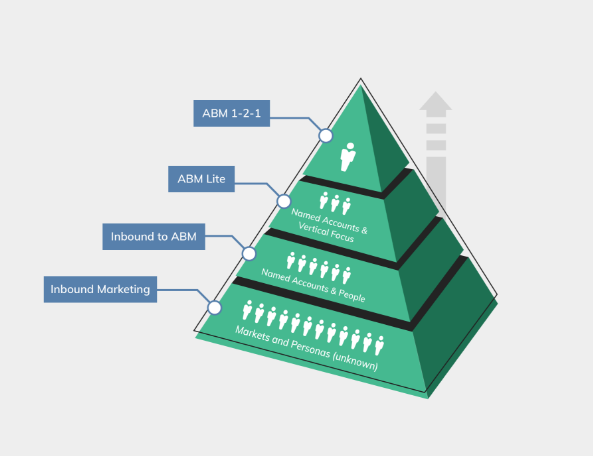Running an Account-Based Marketing (ABM) pilot ahead of a larger campaign can be an effective way to trial, optimise and benchmark activities. So what should a successful ABM pilot campaign consider?

Why ABM, Why Now? Why Run A Pilot?
Account-based marketing is a strategic approach that combines insight-driven marketing with sales to increase awareness, develop relationships and drive growth with specific high-value, high-propensity accounts. It aims to build value, trust and develop buy-in with large numbers of people across varying business functions and decision-making units.
ABM also helps to move perspectives of your business from ‘just a vendor’ to ‘a trusted partner’, and equip account teams with the tools to enable and uncover new opportunities and conversations. In essence, ABM helps to build trust and increase the relevance of your businesses proposition.
Should you run an ABM pilot ahead of a full campaign investment?
ABM pilots are a best practice approach to launching full account-based marketing programmes as they help to outline the activities, timescales and outcomes of a full ABM campaign. They also help to establish realistic goals and ensure teams have the right resources in place ahead of a full campaign.
Below we discuss some considerations to bear in mind when running an ABM pilot.
7 Considerations For An Effective ABM Pilot
1. Develop Your Pilot Framework
A solid ABM pilot framework should consider a number of aspects:
- Programme scoping, to set programme parameters and approach, define realistic goals and KPIs, secure internal buy-in, set the pilot duration and more.
- Insight development, to develop sophisticated insights on accounts and decision makers to inform campaign messaging and targeting.
- Proposition and messaging development, based on insight development, to develop value propositions and campaign messaging for your specific account, business unit or contact.
- Execution plan development, to define the right execution tactics to deliver the value propositions defined earlier in the framework.
These framework steps should ensure that your pilot campaign is well-considered and realistically planned for success.
2. Assess Your Starting Point
Before running a pilot, it’s important to assess your organisation’s ideal ABM starting point, based on current ABM maturity. There are multiple starting point possibilities with an ABM campaign; your insights maturity, available resources, internal buy-in and more will all influence how specific the campaign will be.
Those organisations with a high level of ABM maturity may be able to target at an ABM 1-to-1 level; using account and content specific insight to target individual contacts and accounts who are highly engaged, with specifically personalised content. Equally, organisations with an account/vertical-only level of insight can target at an ABM Lite level, and organisations with a persona-level of insight can target at an Inbound to ABM level, or Inbound level.

3. Set Realistic Timescales
To achieve the best value and results, we recommend that an ABM pilot should run for a minimum of 6+ months. However, a pilot that starts with a high level of ABM maturity and insight may be able to see results faster.
When thinking about pilot timescales, remember these will be impacted by a number of factors such as the size of the sales team and amount of internal resource available. Your existing insight maturity / ABM starting point, level of executive buy-in and sales team alignment will also contribute to the time needed.
4. Consider Your Tech Stack
With the right technology, it’s possible to gain deeper account-level insight, profile stakeholders, gauge buyer propensity, identify the correct mix of media and channels to engage on and more.
An effective ABM tech stack should include:
- A CRM (customer relationship management tool). This should integrate with your marketing automation platform, and is essential for successful sales and marketing alignment.
- Marketing automation platform and reporting, (such as HubSpot), to centralise all of your marketing and sales activity; collating all interactions and touchpoints for complete intelligence.
- CMS (content management system). This again must integrate with your marketing automation platform.
- Programmatic and digital advertising tools. These allow you to use a range of IP targeting, domain-based targeting, geofencing keyword and third-party cookie targeting to precisely segment content to key accounts.
- Social listening and intent data tools. These are key to develop insights, intent data and build trust with key accounts.
Remember, for best campaign tracking and reporting, every tool and platform used in a campaign should integrate.
5. Consider Investment and Budget
The budget that an ABM pilot requires depends on a number of factors and can vary from campaign to campaign. To accurately assess ABM budget, you should take into account:
- Content production costs
- Paid channel budget
- Offline asset production
- Multimedia budget
- Time required to develop insights
- Number of target accounts
- Tech stack investments
The length of the pilot, of course, will also impact the total investment required. So, in order to make an informed assessment of cost implications, an assessment of your starting point must be made first.
6. Define Metrics to Measure
ABM does not focus purely on lead generation, but on expanding relationships with quality accounts. It is also traditionally hard to quantify as a lot of activity occurs offline. However, these metrics may help to measure success:
- Net new leads
- Revenue
- Net new contacts
- Net new accounts
- AQL
- Content signups
- Engagement
- Customer perception
7. Avoid Common Errors
Understanding how to develop and action a successful ABM strategy can be complex. From defining key account criteria, to setting goals, expanding accounts, creating relevant content and reporting - there’s a lot to consider.
Common reasons for failed pilots include:
- The pilot set unrealistic objectives within a short timescale. It’s crucial that the length of your pilot reflects your starting point appropriately.
- The pilot did not secure relevant insight
- Campaign content was not personalised enough
- The pilot did not secure executive buy-in / sales buy-in / manage internal expectations.
- The pilot lacked the integrated tech stack to support activity.
Should a pilot run into any errors, these should be reviewed and resolved ahead of investment in a full ABM campaign is started - pilots campaigns are a great time to test and optimise activities ahead of larger scale activity!
Plan A Pilot To Ensure Long-Term Success
By completing an ABM Pilot, your team will be able to gauge the resources, time and budget required, and ensure that risk is minimised when it comes to executing a more in-depth ABM programme.






